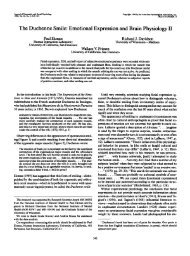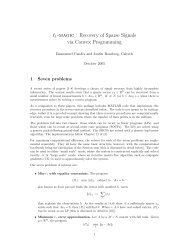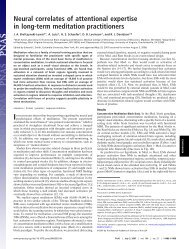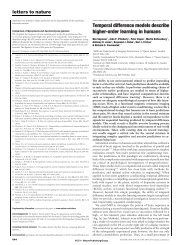Deconvolution Analysis of FMRI Time Series Data - Waisman ...
Deconvolution Analysis of FMRI Time Series Data - Waisman ...
Deconvolution Analysis of FMRI Time Series Data - Waisman ...
You also want an ePaper? Increase the reach of your titles
YUMPU automatically turns print PDFs into web optimized ePapers that Google loves.
v2.motion.1D as the \ort" function input. Use afni to compare the 3dm+ output obtainedwith and without the motion parameters. Also, compare the 3dDeconvolve outputparametric maps with the 3dm+ parametric maps.What general conclusions do you reach?Example 1.4.3.4 Multiple Experimental Input Stimuli No NoiseA researcher wants to perform a multiple linear regression on <strong>FMRI</strong> time series datato distinguish dierent regions <strong>of</strong> neural activation based upon dierences in linguisticprocessing. In this experiment, the subject is shown a sequence <strong>of</strong> \words" that fall intoone <strong>of</strong> three categories: 1) \Random": the letters which make up the \word" are selectedat random, but with the same marginal probabilities as occur in English language text2) \Markov": the letters which make up the \word" are chosen with the same 1st orderMarkov probabilities that are found in English and 3) \English": actual English words.LettingX = No inputR = Random inputM = Markov inputE = English inputthe sequence <strong>of</strong> experimental inputs is given by:X R M E X M X E R X R E M X X X M E R XIn this example, there are three separate stimulus time series functions, corresponding tothe times <strong>of</strong> presentation for the three dierent word categories.r(t)m(t)e(t)===fff0 1 0 0 0 0 0 0 1 0 1 0 0 0 0 0 0 0 1 00 0 1 0 0 1 0 0 0 0 0 0 1 0 0 0 1 0 0 00 0 0 1 0 0 0 1 0 0 0 1 0 0 0 0 0 1 0 0Store these rows as single columns into les Random.1D, Markov.1D, and English.1D, respectively.Since the researcher is not interested in the impulse response function per se, but isinterested in decomposing the output as a linear function <strong>of</strong> the dierent input stimuli,only a few time lags will be used for estimating each individual input stimulus response.These time lags are used to allow for diering rates <strong>of</strong> response to the stimulus in dierentvoxels.Let the 0-2 point IRF's be:h R (t)h M (t)h E (t)===fff2 7 51 4 63 9 2Verify that the result <strong>of</strong> convolving these IRF's with the individual stimulus functions,and adding the results, is the following:y(t) = r(t) h R (t)+m(t) h M (t)+e(t) h E (t)= f 0 2 8 12 15 3 4 9 11 9 7 10 15 6 6 0 1 7 17 9 g39gggggg




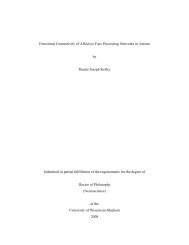
![[F-18]-L-DOPA PET scan shows loss of dopaminergic neurons](https://img.yumpu.com/41721684/1/190x146/f-18-l-dopa-pet-scan-shows-loss-of-dopaminergic-neurons.jpg?quality=85)
